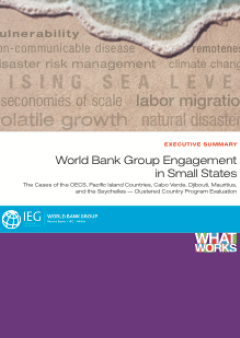
World Bank Group Engagement in Small States
This clustered Country Program Evaluation (CPE) concerns small states (defined as those that have a population of less than 1.5 million) and is the second in a new IEG product series. Though small states differ widely, they share several challenges, including those of strengthening their resilience to economic and natural disaster-related shocks and of remaining competitive to generate vigorous economic growth.
In addition to this overview report, the clustered CPE includes evaluations of the World Bank Group programs in the six Organisation of Eastern Caribbean States (OECS) countries (Volume 1 and Volume 2), and nine Pacific Island countries (PICs) (Volume 1 and Volume 2). It also assessed four African country programs (Cabo Verde, Djibouti, Mauritius, and the Seychelles) more selectively. The evaluations in the cluster used a common framework based on two pillars: strengthening resilience and enhancing competitiveness.
This overview report, which seeks to facilitate cross learning, selectively discusses strategic and operational approaches that the World Bank Group used and development issues that it addressed during 2006-14 in the regional and country programs evaluated. It focuses on the engagement aspects that hold particular interest for small states.
Among the strategic and operational approaches that the World Bank Group used to respond to the more constraining parameters that small state country teams confront were engaging on a regional or multicountry level, addressing country capacity limitations (including capacity for program implementation), and using partnerships to engage jointly or in a coordinated way with others.
Thematically, the small state programs deployed several approaches and addressed key development issues geared to the client countries' small size, seeking to strengthen macroeconomic, disaster and climate, and social resilience, as well as enhance competitiveness by facilitating trade, strengthening the financial sector, expanding infrastructure and improving its management, and supporting leading sectors (such as tourism, fisheries, and agriculture). For example, World Bank support helped clients strengthen their disaster risk management by improving preparedness, enhancing infrastructure resilience, and focusing government planning on resilience.
The program evaluations raise issues for World Bank Group consideration in its engagement with small states—relating to the thematic aspects of engagement and to the cross-cutting aspects at both at the country team and institutional levels. For example, at the country team level, contingency planning, including the use of contingent financing instruments, has a key role to play in enhancing World Bank responsiveness to the shocks that small states suffer. At the institutional level, issues that merit consideration include whether small state IDA allocations can be made more responsive to vulnerability, and whether small state–specific World Bank and IFC financing instruments are worth developing.
